PESTS AND DISEASES OF FORESTRY IN NEW ZEALAND
Control of eucalypt and blackwood pests with the southern lady bird Cleobora mellyi - a possibility?
Farm Forestry Association Eucalyptus Action Group and Acacia Melanoxylon (Blackwood) Action Group, MAF Sustainable Farming Fund Grant 2004/2005 and 2006:
Contact person: Dean Satchell, RD1 Kerikeri, Northland, New Zealand. Phone (09) 407 5525
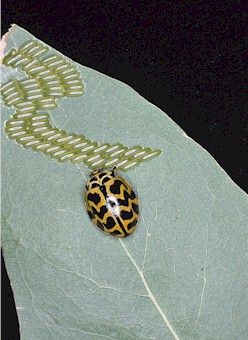
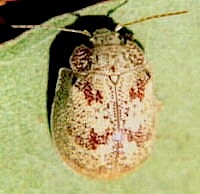
Cleobora mellyi, the southern ladybird, was introduced into New Zealand from Tasmania in 1977 for control of the eucalypt tortoise beetle, Paropsis charybdis. This specialist ladybird diets on psyllids and tortoise beetles, pests of both blackwood (Acacia melanoxylon) and eucalypts. However Cleobora has been geographically isolated in the Marlborough Sounds for twenty five years and therefore unavailable to farm foresters as a tool for controlling pests in their plantations.
The Eucalypt Tortoise Beetle
Since early last century, eucalypt trees in New Zealand have been under siege by the tortoise beetle Paropsis charybdis, an Australian beetle which at both the larval and adult stages has a voracious appetite for eucalypt foliage. In 1987 a biological control agent.
Enoggera nassaui was introduced from Australia in a partially successful effort to control the pest. However, in Forest Health News 117, April 2002, it was reported that E. nassaui is itself now under attack from a hyperparasitoid Baeoanusia albifunicle. B. albifunicle checks the population growth of E. nassaui and prevents it from multiplying as rapidly as it has in past seasons. This is likely to have serious consequences, since until now E. nassaui has been the only biological control agent effective against P. charybdis in this country. The discovery of a second insect, also reported in Forest Health News 117, April 2002, a tiny wasp identified as Neopolycystus sp., may hold some hope for controlling P. charybdis, as this species, like E. nassaui, is a primary parasitoid of eucalypt leaf beetles such as Paropsis spp. in Australia.
Cleobora- the history
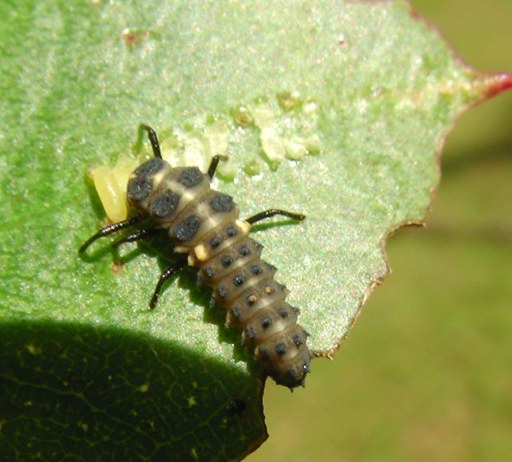
Australian predators and parasites of P. charybdis have been investigated in New Zealand as potential biological control agents since the 1930s, and in 1977 Cleobora mellyi the Southern Ladybird was imported from Tasmania. These were reared and 3000 adult Cleobora were released in eucalypt plantations in the central North Island, Christchurch and the Marlborough Sounds. Adults were subsequently found overwintering under bark in the latter release area, and Cleobora established only in the Marlborough Sounds, in a mixed Eucalyptus and Acacia plantation. The effect of Cleobora on P. charybdis populations there was never determined, and work on Cleobora was abandoned.
It is likely that Cleobora did not establish in the other release sites because blackwoods, and therefore the most important component of the natural diet for this ladybird, Blackwood psyllids, were not present. At that time, only one species of eucalypt psyllid was present in New Zealand, Ctenarytaina eucalypti, the blue-gum psyllid. This psyllid is only present on juvenile foliage of blue-gums. Beetles, including ladybirds and tortoise beetles are not found on juvenile blue-gum foliage because it is too waxy and their feet cannot grip on its surface (confirmed by recent observations in the Marlborough Sounds where Cleobora were not found on juvenile blue-gum foliage despite abundant blue-gum psyllids feeding on the foliage).
Furthermore, Paropsis charybdis eggs, which are eaten by Cleobora, are known to be laid in cycles, so at times Cleobora would require abundant psyllids to feed on.
The Forgotten Ladybird
Twenty five years later the Eucalypt Action Group confirmed that Cleobora is both present and abundant in the mixed blackwood/ eucalypt stand at Maori Bay in the Marlborough Sounds. This population appear to be effectively controlling psyllids on the Blackwoods on which they are common. In October 2005 Richard Davies-Colley and Dean Satchell travelled to the Marlborough Sounds to assess this population and a report was produced.
Ladybirds have been collected and a rearing/release program has produced and released Cleobora in the North island.
Eucalypts
Since the original introduction of Cleobora into New Zealand , a number of pest psyllid species have become established on eucalypts in New Zealand including the shoot psyllids Blastopsylla occidentalis and Ctenarytaina spatulata. These are now very common on a wide range of eucalypt species, and an ideal food for Cleobora. Other recent eucalypt psyllid introductions include Cardiaspina fiscella (a serious pest of Eucalyptus saligna and E. botryoides), Glycaspis granulata, Eucalyptolyma maidenii, Cryptoneossa triangulata, Creiis lituratus and Anoeconeoassa communis, all pests of eucalypts and potential food for Cleobora.
Two more Australian eucalypt tortoise beetles, likely food sources for Cleobora, have also established in New Zealand since the original introduction attempt. Trachymela catenata has established in the Gisborne area, and Trachymela sloanei first found in Auckland in 1976, has spread to other parts of the country causing some concern for eucalypt growers. The diversity of these pests suggest an adequate food source for Cleobora that was not available in 1980.
Blackwoods
Blackwood tortoise beetle
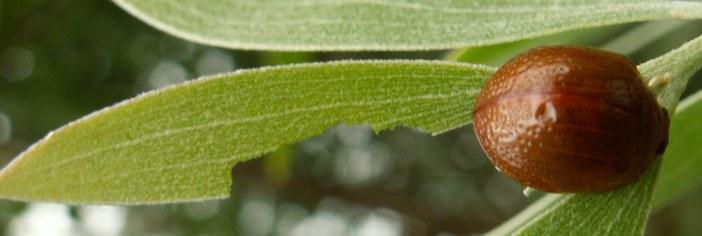
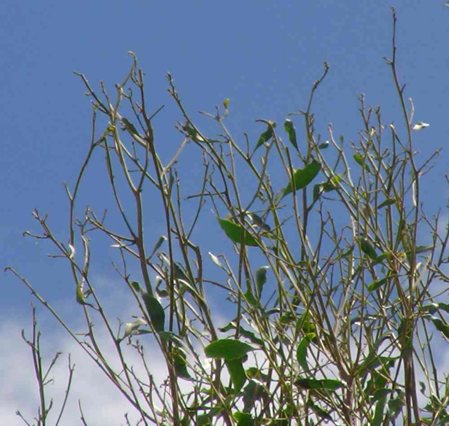
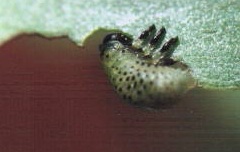
The blackwood tortoise beetle, Dicranosterna semipunctata, first discovered in Auckland in 1996, has become established on Acacia melanoxylon, Tasmanian blackwood. This pest has now spread through the top half of the North Island and is of major concern to growers of this valuable timber.
Recent feeding trials by the Eucalyptus Action Group have shown that both the eggs and larvae of the blackwood tortoise beetle are eaten by Cleobora.
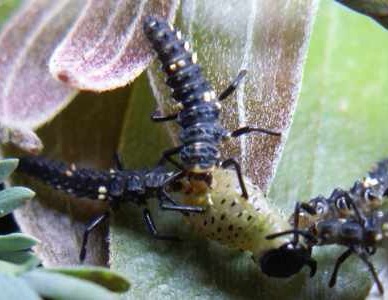
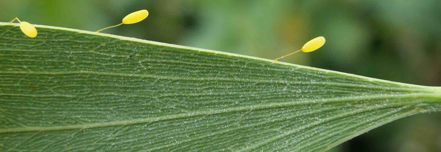
Blackwood psyllids
Blackwood psyllids are present throughout the year, with population peaks in late spring, and at the completion of the growing season in autumn. It is very likely Cleobora will effectively control this pest in our blackwood plantations.
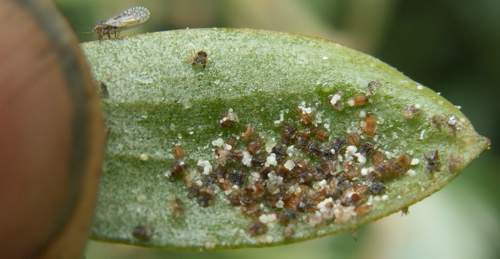
It was noted in a recent Tasmanian study that in April, blackwood seedlings bordering a eucalypt plantation carried large numbers of newly emerged Cleobora ladybirds feeding on psyllids prior to overwintering. The ladybirds were not found in the plantation at this time despite some tortoise beetle eggs being available on the plantation eucalypts. This indicates a dietry preference for psyllids.
Solutions?
It is likely Cleobora will emerge in spring at the same time as Paropsis, when Paropsis causes the most damage (See Paropsis Charybdis Defoliation of Eucalyptus Stands in New Zealand's Central North Island pdf published in 2000). It is therefore possible that Cleobora may provide some level of control over Paropsis in eucalypts, facilitated by the presence of psyllids.
The signs are encouraging that the insect diversity required for good levels of control of a number of insect pests by Cleobora on Eucalyptus and Acacia is present, and the mindset of industry is there for the promotion of naturally sustainable biological control options.
Distribution and release
Releases of Cleobora were made in the North Island and Southland during 2006 and 2007 in mixed blackwood/eucalypt plantations. We hope this is the first step towards improving the biological control of a large number of eucalyptus and acacia pests currently established in New Zealand, while also providing Farm Forestry Action Group members with much needed experience in both this field and also building links between supporting members, e.g. industry, farm forestry and govt departments.
Cleobora has established in several sites in the North Island . We now hope to study pest/ predator dynamics, and hopefully document good control of target pests. If you have a mixed eucalypt / blackwood or blackwood plantation where you would like to release this ladybird please get in touch with us.
Dean Satchell has been working on intensive mass rearing systems for three years and has devised artificial diets and techniques suitable for rearing large numbers of this beneficial insect inexpensively and easily.
last updated May 2010
Many thanks Nod Kay for "seeding" this ladybird in our minds...
Also many thanks also to Brian Richardson and John Bain of Forest Research for supporting our application and making this possible, and also Dick Bashford of Forestry Tasmania for all his advice and support.
Eucalyptus Action Groups successful application 2004/2005
Acacia melanoxylon Action Group (AMIGO) successful application 2006/2007

 Farm Forestry New Zealand
Farm Forestry New Zealand

